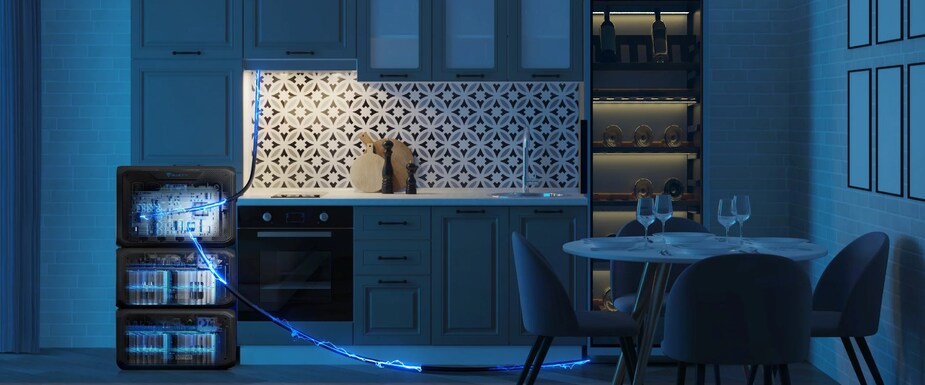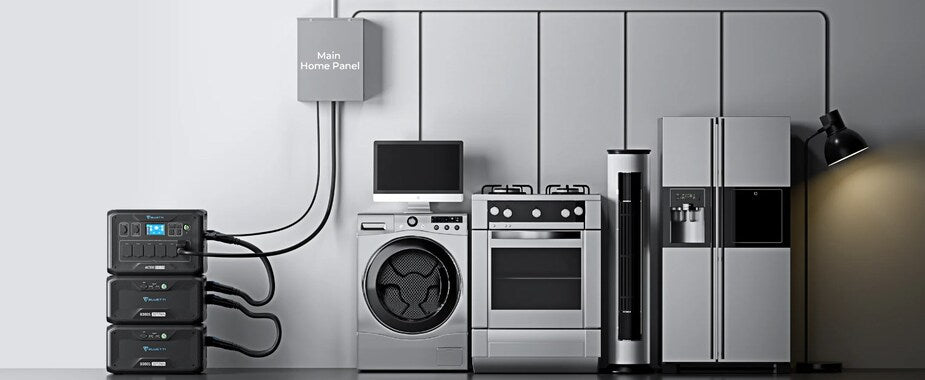Do mini-fridges use a lot of electricity? Refrigerators are no longer the massive energy wasters they previously were, thanks to the development of more energy-efficient versions. Still, a sizable amount of your electricity cost is attributed to their power usage. You might be a good candidate for a tiny fridge if you live alone and don't frequently stock your refrigerator with fresh food. Their energy usage is still a major consideration when deciding whether or not to purchase them, though. In any case, how much electricity does a compact fridge consume? Let's investigate and look for ways to reduce its electrical expenses while we're at it.
What is a Mini Fridge?
In terms of keeping your food fresh and your drinks cold, a micro-fridge is comparable to a standard refrigerator. Also, the features and functionalities of the two versions are nearly identical. A micro refrigerator, on the other hand, is made to fit in small places, unlike a standard refrigerator.
Because of this characteristic, many people who live in small flats or dorms choose it. The smaller model's energy usage is another factor that makes people choose it. Generally speaking, a small refrigerator uses less electricity than a large refrigerator.
Average Energy Consumption
A fridge is a need for any home. However, for convenience, some homes decide to install a tiny fridge. Because power is costly, the amount of electricity mini-fridges use is frequently a determining factor when determining whether the convenience of owning a small refrigerator justifies the cost of electricity usage.
So, what is the electrical consumption of a tiny fridge?
Mini fridge energy consumption varies based on a number of factors. The number of kilowatt hours they use is influenced by factors such as their age, model, size, energy efficiency, and surrounding ambient temperature.
The sizes of mini refrigerators typically range from 1.7 to 4.4 cubic feet. Energy Star estimates that mini-fridges of this size consume between 233 and 310 kWh. In the meantime, tests conducted by Consumer Reports show that an energy-efficient 4.4 cubic foot mini fridge has an annual energy cost of $27.
Do Mini Fridges Use A lot of Electricity?
\You might be curious about how much a compact refrigerator will contribute to your home's annual electricity use, given the escalating cost of electricity. Thankfully, there's a simple learning method. You must ascertain the wattage, or the number of watts required for small fridges to function, in order to compute the amount of electricity they consume.
Look for the small refrigerator's volts and amps on the sticker inside the refrigerator if you are still looking for the information on the equipment or manual. To determine the machine's wattage, multiply these figures.
You can calculate your micro fridge's power consumption once you know its wattage. Here's how you can accomplish it.
- The amount of hours the mini fridge runs in a day can be found by multiplying its running wattage by 24.
- The watts (W) can be converted to kilowatts (kW) by dividing the value by 1,000.
- Examine your electricity bill to find the cost per kilowatt-hour (kWh).
- To calculate how much it will cost to operate your mini fridge each day, multiply the kW by the kWh rate.
- To find the monthly energy expenditures for your tiny fridge, multiply the daily costs by thirty.
- Multiplying the monthly expenses by 12 will get the annual energy use.
It is an illustration of how to calculate the energy consumption of a small refrigerator. Assume the local electricity tariff is $0.10 per kilowatt-hour, and the tiny refrigerator has a wattage of 250.
- 250 watts x 24 hours = 6,000 watts (W)
- 6,000 ÷ 1,000 = 6 kilowatt hours (kWh)
- 6 kWh x $0.10 per kWh = $0.60 per day
- 0.60 x 30 = $18 per month
- 18 x 12 = $216 a year
Factors Affecting the Power Consumption of Refrigerators
Refrigerator energy consumption varies, with smaller fridges using less energy than full-size ones. Daily energy usage depends on the watts required to run the appliance.
- Usage:
How you use your refrigerator impacts energy consumption. Overloading or neglecting gaskets hinders airflow, forcing the compressor to overwork. An empty fridge also challenges efficiency, as the compressor compensates for lost, cold air, increasing energy consumption.
Regularly opening the Door increases power consumption, compelling the compressor to work harder and raising energy usage by about 7 percent.
Fridge configuration affects cooling and power consumption. Bottom freezers use 16 percent less energy than side-by-side models. Manual defrost versions consume half the energy, while models with anti-sweat heaters may use 5 to 10 percent more power.
Larger fridges consume more electricity, leading to higher bills. Mini fridges use 233-310 kWh, while full-size ones consume 404-613 kWh.
Installation in the coolest part of the room enhances efficiency. Temperatures below 10 degrees Celsius may affect proper functioning.
Models may use more energy in summer due to higher temperatures. Cold weather tends to decrease power consumption.
Adjusting thermostat settings impacts operating costs. Higher settings lead to increased power usage, with a potential 25 percent higher consumption for fridges set 10 degrees colder.
How to Decrease Your Mini Fridge’s Energy Use?
Reducing your mini fridge's energy consumption can save you money on electricity costs. Follow these tips:
Keep the Door Closed: Limiting the time the Door is open prevents cold air loss and reduces the compressor's workload, saving energy.
Choose Energy Star-certified: Opt for appliances with an Energy Star rating, as they are 9-15 percent more energy-efficient than non-certified models, leading to potential long-term savings.
Keep Coils Clean: Dirty coils hinder the fridge's cooling efficiency, potentially increasing energy consumption by up to 83 percent. Regular cleaning not only lowers energy use but also extends the appliance's lifespan.
Optimal Placement: Avoid placing the fridge in warm areas, such as near ovens or radiators, as it forces the appliance to work harder to maintain the desired temperature, increasing energy usage and expenses.
Ensure Good Ventilation: Adequate ventilation is crucial to prevent overheating and overworking of the motor, leading to higher energy consumption. Maintain at least a 5-centimeter space around the back, top, and sides of the fridge for proper air circulation.
Use Timer Switches: Implement timer switches to control the fridge's operation based on your settings. While not turning off the refrigerator completely, using a power-saving mode during low usage times can reduce energy consumption.
Adjust Temperature Settings: Set optimal temperature ranges (between 5-18 degrees Celsius) for both the fridge and freezer to ensure food freshness without unnecessary energy consumption. Avoid excessively low temperatures that drive up power usage.
How to Decrease Your Home’s Energy Use?
The BLUETTI AC500 + B300S Home Battery Backup system stands out as a robust and versatile power solution. Boasting a 5,000W rated power (with a surge capacity of 10,000W), this system provides a reliable source of electricity for various devices and appliances. What sets it apart is its impressive expandable capacity, ranging from 3,072Wh to 18,432Wh, offering flexibility to adapt to different energy needs. The utilization of a LiFePO4 battery ensures durability, with over 3,500 life cycles to 80%, making it a resilient and long-lasting energy storage solution.

The smart features of the BLUETTI AC500 + B300S are highlighted by its Smart APP Control, allowing users to manage the system effortlessly through WiFi and Bluetooth connections. With six ways to recharge, including AC, solar, car, generator, lead battery, and dual charging options, this home battery backup system ensures adaptability to various charging scenarios. The inclusion of 16 versatile outlets further enhances its usability, catering to a wide range of electronic devices. Additionally, tying it to the home grid for a 24/7 uninterruptible power supply (UPS) makes it a reliable backup during power outages.

Frequently Asked Questions (FAQs)
Q1: How Long is the Typical Lifespan of a Mini Fridge?
The durability of mini fridges varies due to several factors influencing their longevity. As a rough estimate, you can anticipate your compact refrigerator to remain functional for about 12 years.
Q2: What is the Shelf Life of Food in a Mini Fridge?
Mini fridges excel at preserving the freshness of food, akin to full-size refrigerators. Some models, however, may have less powerful freezers, limiting the safe storage of meat and poultry for extended periods.
Q3: Is it Safe to Keep a Mini Fridge in the Bedroom?
In terms of safety, having a mini fridge in the bedroom poses no significant risks. The drawbacks of having one in your sleeping space primarily relate to potential discomfort caused by increased room temperature and the noise generated by a loud compressor.
Q4: What Alternatives Can I Use Instead of a Mini Fridge?
If you wish to avoid the additional expense of purchasing a small refrigerator, you can opt for a cooler and fill it with ice. While this method can maintain food freshness for a limited time, it's not suitable for storing meat due to food safety concerns.
Conclusion
Do mini fridges use a lot of electricity? The electricity consumption of mini fridges depends on various factors such as size, model, and usage patterns. While mini-fridges are generally designed to be energy-efficient, their actual power usage can vary. Factors like the size of the fridge, its cooling technology, and how frequently the Door is opened contribute to the overall electricity consumption. To minimize energy costs, it is advisable to choose an appropriately sized mini fridge, maintain it well, and be mindful of usage habits.
